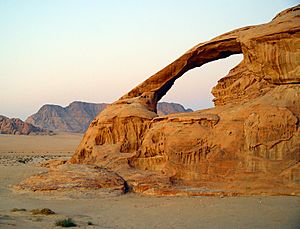Erosion facts for kids
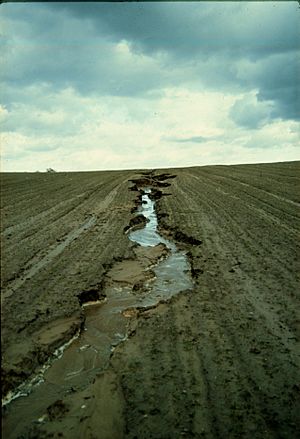
Erosion is a natural process where soil, rock, or other materials are moved from one place on Earth to another. This movement is usually caused by forces like water flow or wind. After being moved, these materials are then dropped off, or deposited, in a new location.
It's important to know that erosion is different from weathering. Weathering breaks down rocks and soil, but it doesn't move them. Erosion, on the other hand, is all about the movement. When rocks or soil are physically carried away, it's called physical erosion. When they are dissolved and then carried away, it's called chemical erosion. These materials can travel short distances, like a few millimeters, or very long distances, even thousands of kilometers!
Many things cause erosion. These include rain, rivers, waves hitting the coast, glaciers scraping the land, floods, and wind. Even gravity causes erosion when it pulls soil and rocks down steep slopes in events like landslides. The speed of erosion depends on many things, like how steep the land is, how much rain falls, how strong the wind blows, and the temperature.
Erosion is a natural part of Earth's cycle. However, human activities have greatly sped up the rate of soil erosion. In some places, human actions have increased erosion by 10 to 40 times the natural rate. For example, in the Appalachian Mountains, intense farming has caused erosion to be up to 100 times faster than it would naturally be.
Too much erosion can cause big problems. On farms, it means less fertile soil, which makes it harder to grow crops. In natural areas, it can harm ecosystems. Sometimes, it even leads to desertification, where fertile land turns into desert. Erosion can also cause problems far away from where it starts. It can fill rivers and lakes with sediment, making the water dirty and harming aquatic life. It can also damage roads and buildings. Water erosion and wind erosion are the main reasons for land degradation worldwide, affecting about 84% of degraded land. This makes excessive erosion a major environmental problem.
Activities like intensive farming, cutting down forests (deforestation), building roads, and urban sprawl (cities growing bigger) all contribute to more erosion. Luckily, there are many ways to prevent or reduce erosion, which we will explore later.
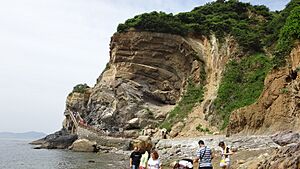
Contents
How Erosion Happens: Physical Processes
Rainfall and Surface Runoff
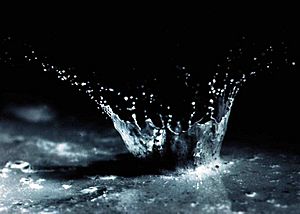
Rainfall and the water that flows over the surface (surface runoff) cause four main types of soil erosion. These are splash erosion, sheet erosion, rill erosion, and gully erosion. Splash erosion is the first and usually least damaging type, followed by sheet, rill, and then gully erosion, which is the most severe.
In splash erosion, a falling raindrop hits the soil. This impact creates a tiny crater and throws soil particles into the air. These particles can travel quite far, sometimes over half a meter high and more than a meter sideways.
If the soil is full of water, or if rain falls too fast for the soil to soak it up, water starts to flow over the surface. This is called surface runoff. If this runoff moves fast enough, it carries away the loosened soil particles. This process is called sheet erosion. It removes thin layers of soil evenly across a slope.
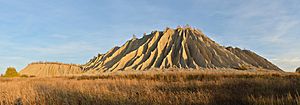
Rill erosion happens when the flowing water starts to create small, temporary channels or grooves in the soil. These rills act like tiny rivers, carrying soil down the hillside. Rills are usually only a few centimeters deep.
Gully erosion is a more serious type of erosion. It occurs when runoff water gathers and flows rapidly in larger, deeper channels. These channels are big enough that they cannot be easily removed by normal farming tools. Gully erosion removes a lot of soil and can create deep ditches.
When gully erosion becomes very extreme, it can lead to the formation of badlands. These are areas with very rugged, deeply eroded terrain. Badlands often form in places with soft rocks and little protective vegetation.
Rivers and Streams
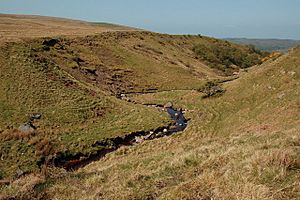
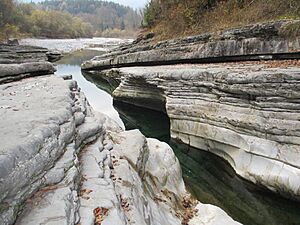
Rivers and streams constantly erode the land as water flows through them. This valley erosion deepens the valley and also extends it further into the hillside. At first, rivers mostly cut downwards, creating V-shaped valleys with steep sides. As the river gets closer to its base level (the lowest point it can erode to), it starts to erode more sideways. This widens the valley floor and creates a flat area called a floodplain.
The most erosion in rivers happens during floods. More water moving faster carries a larger amount of sediment. It's not just the water that erodes; the sand, pebbles, and boulders carried by the river also scrape and grind against the riverbed and banks. This process is called traction.
Bank erosion is when the sides of a river or stream wear away. This is different from scour, which is erosion of the riverbed itself.
Thermal erosion happens when moving water melts and weakens permafrost (permanently frozen ground). This can occur along rivers and coastlines. For example, the Lena River in Siberia shows rapid changes in its path because thermal erosion causes its permafrost banks to collapse.
Coastal Erosion
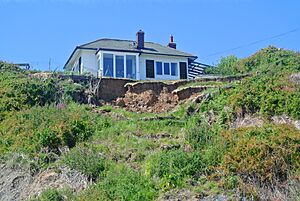
Coastal erosion happens along shorelines, both in open and sheltered areas. It is mainly caused by ocean currents and waves. Changes in sea level (tides) can also play a role.
Waves erode the coast in several ways:
- Hydraulic action: Waves force air into cracks in rocks. When the wave pulls back, the air expands quickly, cracking the rock.
- Wave pounding: The sheer force of waves hitting cliffs or rocks can break off pieces.
- Abrasion: Waves throw sand, pebbles, and rocks against the cliff. This acts like sandpaper, grinding away the rock. This is a very effective form of erosion.
- Corrosion: This is the dissolving of rock by chemicals in seawater, like carbonic acid. Limestone cliffs are especially affected by this.
- Attrition: The rocks and particles carried by waves crash into each other and the cliffs. This breaks them down into smaller, smoother pieces like shingle and sand.
- Bioerosion: Some organisms, like snails or clams, can bore into or scrape rocks, causing erosion.
Sediment is also moved along the coast by currents in a process called longshore drift. If more sediment is carried away than is supplied, erosion occurs. If more sediment arrives than is carried away, sand or gravel banks will form. These banks can shift over time, protecting or exposing different parts of the coastline. Sometimes, a bend in the coastline can cause eroded material to build up, forming a long, narrow bank called a spit.
Chemical Erosion
Chemical erosion is when rock and soil material are removed from a landscape by being dissolved in water. This dissolved material is then carried away by streams and rivers.
A great example of chemical erosion is the formation of sinkholes and karst topography. This happens when limestone bedrock is slowly dissolved by rainwater, creating caves and depressions in the ground.
Glaciers
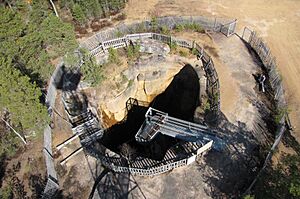
Glaciers are powerful agents of erosion. They erode the land mainly through three processes:
- Abrasion: As a glacier moves, the rocks and debris frozen into its bottom scrape against the ground below. This acts like giant sandpaper, polishing and gouging the underlying rocks. Over long periods, this can carve out U-shaped valleys.
- Plucking: Glaciers can freeze onto pieces of bedrock. As the glacier moves, it pulls these pieces of rock away from the ground.
- Ice thrusting: Sometimes, a glacier freezes to its bed and then pushes forward, moving large sheets of frozen soil and rock along with it. This process helped create many lake basins in places like the Canadian Shield.
Glaciers are so effective at eroding mountains that scientists sometimes use the term glacial buzzsaw. This describes how glaciers can limit the maximum height of mountain ranges. As mountains get taller, they often experience more glacial activity, which increases erosion and can prevent them from growing even higher. However, in some very cold areas, glaciers can also act as glacial armor, protecting mountains from other forms of erosion.
After glaciers retreat, they leave behind unique landforms. These include moraines (piles of rock and sediment), drumlins (oval-shaped hills), and glacial erratics (large boulders left far from their original source).
Floods
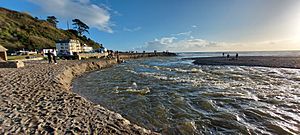
During extremely high flows, like those in a flood, rapidly moving water can create powerful swirling currents called kolks or vortices. These kolks cause intense local erosion, pulling out pieces of bedrock and forming deep, circular holes called rock-cut basins. A famous example is the channeled scablands in eastern Washington, which were carved by massive glacial floods.
Wind Erosion
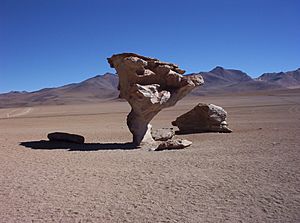
Wind erosion is a major force that shapes the land, especially in dry (arid) and semi-dry areas. It is also a significant cause of land degradation, leading to desertification, harmful airborne dust, and damage to crops. Human activities like deforestation and agriculture have greatly increased wind erosion beyond natural rates.
Wind erosion happens in two main ways:
- Deflation: The wind picks up and carries away loose particles. This can happen in three forms:
- Surface creep: Larger, heavier particles slide or roll along the ground.
- Saltation: Particles are lifted a short distance into the air, then bounce and skip across the surface. This is responsible for most wind erosion (50-70%).
- Suspension: Very small and light particles are lifted high into the air and can be carried for very long distances.
- Abrasion: Surfaces are worn down as they are hit by airborne particles carried by the wind. This is like sandblasting.
Wind erosion is much worse in dry areas and during droughts. For example, in the Great Plains of the United States, soil loss due to wind erosion can be thousands of times greater in dry years compared to wet years.
Mass Wasting
Mass wasting, also known as mass movement, is the downward movement of rock and sediments on a sloped surface. This movement is mainly caused by the force of gravity.
Mass wasting is a key part of erosion, especially in mountainous areas. It moves material from high elevations to lower ones. Once at lower elevations, other agents like streams and glaciers can pick up the material and move it even further. Mass-wasting processes happen all the time on all slopes. Some are very slow, while others happen suddenly and can be disastrous, like landslides.
Slumping occurs on steep hillsides. A block of soil or rock slides down a curved surface, often in materials like clay. This can leave a spoon-shaped depression where the material used to be. Water beneath the slope can weaken it and cause slumping.
Surface creep is the very slow, gradual movement of soil and rock debris down a slope due to gravity. It's usually so slow that you can only notice it over a long time.
Submarine Sediment Gravity Flows
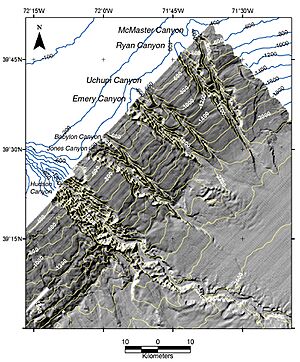
On the continental slope (the underwater slope from the continent to the deep ocean), erosion of the ocean floor creates channels and submarine canyons. This happens because of fast-moving underwater flows of water mixed with sediment, called turbidity currents. These currents can erode deep channels into the ocean floor.
When turbidity currents erode slopes too much, they can also trigger underwater landslides and debris flows. Submarine canyons act like highways, moving sediment from the continents and shallow seas to the deep ocean. The layers of sediment left by these currents, called turbidites, are some of the thickest on Earth. This shows how important these erosional processes have been throughout Earth's history.
What Affects Erosion Rates?
Climate
The amount and strength of precipitation is the main climatic factor that controls how much soil is eroded by water. Erosion is especially strong when heavy rain falls on soil that isn't protected by vegetation. This can happen in farm fields after harvest or in dry regions where plants are naturally sparse.
Wind erosion needs strong winds, especially during droughts when the soil is dry and there are few plants to hold it in place. Other climate factors like average temperature can also affect erosion by influencing plant growth and soil properties. Generally, areas with more rain (especially intense storms), stronger winds, or more storms will experience more erosion.
In some places, like the Midwestern United States, the intensity of rainfall is the most important factor. Larger and faster raindrops have more energy, so they can move soil particles further. In other regions, like western Europe, erosion can happen even with lighter rain if the soil is already saturated with water.
Scientists predict that in Europe, rainfall will become more erosive, potentially increasing soil erosion by 13–22.5% by 2050. In Taiwan, an increase in typhoon frequency has been linked to more sediment in rivers, showing how climate change can impact erosion.
Vegetative Cover
Vegetation (plants) plays a crucial role in protecting the soil. Plants act as a barrier between the atmosphere and the soil. They help rainwater soak into the ground, which reduces surface runoff. They also shelter the soil from winds, decreasing wind erosion. The roots of plants bind the soil together, forming a stronger mass that is less likely to be eroded by water or wind. When vegetation is removed, the rate of surface erosion increases significantly.
Topography
The topography (shape) of the land affects how fast surface runoff flows, which in turn determines how much erosion it causes. Longer, steeper slopes, especially those without enough plant cover, are much more likely to experience high rates of erosion during heavy rains than shorter, less steep slopes. Steeper land is also more prone to mudslides, landslides, and other gravity-driven erosion processes.
Tectonics
Tectonic plate movements, which cause parts of Earth's surface to rise or fall (like forming mountain ranges), directly affect erosion rates. When land is uplifted, it becomes steeper, and erosion rates usually increase. Tectonic activity also brings fresh, unweathered rock to the surface, where it is then exposed to erosion.
Interestingly, erosion can also affect tectonic processes. When large amounts of rock are removed by erosion from an area, it lightens the load on the crust and mantle below. This "unloading" can cause the land to rise up, a process called isostatic uplift. This creates a feedback loop where erosion can influence the very forces that shape mountains.
Human Development
Human development, including agriculture and urban sprawl, is a major factor in erosion and sediment transport. This can worsen food insecurity. For example, in Taiwan, increases in river sediment have been linked to the timeline of development in different regions throughout the 20th century. Humans intentionally removing soil and rock is also a form of erosion, sometimes called lisasion.
Erosion at Different Scales
Mountain Ranges
Mountain ranges take millions of years to erode away. Experts estimate it could take over 450 million years for a mountain range like the Himalayas to erode into an almost flat plain, assuming no major changes in sea level. Erosion can sometimes create a pattern where many mountain peaks are all roughly the same height.
An example of heavily eroded mountains are the Timanides in Northern Russia. The erosion of these ancient mountains produced sediments that are now found in the East European Platform. Studies of these sediments suggest that the erosion of the Timanides began in the Cambrian period and became more intense in the Ordovician period.
Soils
Soil erosion is a natural process, but if it happens faster than new soil can form, it destroys the soil. Slower erosion rates can also prevent the development of complex soil features that take a long time to grow.
As mentioned earlier, human activities have greatly increased the rate of soil erosion globally. This excessive erosion causes problems both where it happens ("on-site") and far away ("off-site"). On-site impacts include reduced agricultural productivity and harm to natural landscapes due to the loss of nutrient-rich topsoil. In some cases, this leads to desertification. Off-site effects include sedimentation of waterways (filling rivers and lakes with dirt) and eutrophication (too many nutrients in water bodies), which can harm aquatic life. It can also damage roads and homes.
Water and wind erosion are the two main causes of land degradation, affecting about 84% of degraded land worldwide. This makes excessive erosion one of the most serious environmental problems we face. In the United States, farmers who cultivate highly erodible land often need to follow a conservation plan to receive agricultural support.
Consequences of Human-Made Soil Erosion
Human activities have a significant impact on the environment through soil erosion. This leads to degraded land and can harm our ability to grow food. When topsoil, which is rich in nutrients, is lost, it becomes harder to farm. This can lead to less food production and even food insecurity. The eroded soil can also pollute water sources, affecting both wildlife and human communities.
Images for kids
-
An actively eroding rill on an intensively-farmed field in eastern Germany. This phenomenon is aggravated by poor agricultural practices because when ploughing, the furrows were traced in the direction of the slope rather than that of the terrain contour lines.
-
A natural arch produced by the wind erosion of differentially weathered rock in Jebel Kharaz, Jordan
-
A wave-like sea cliff produced by coastal erosion, in Jinshitan Coastal National Geopark, Dalian, Liaoning Province, China
-
Soil and water being splashed by the impact of a single raindrop
-
A spoil tip covered in rills and gullies due to erosion processes caused by rainfall: Rummu, Estonia
-
Dobbingstone Burn, Scotland, showing two different types of erosion affecting the same place. Valley erosion is occurring due to the flow of the stream, and the boulders and stones (and much of the soil) that are lying on the stream's banks are glacial till that was left behind as ice age glaciers flowed over the terrain.
-
Layers of chalk exposed by a river eroding through them
-
Erosion of the boulder clay (of Pleistocene age) along cliffs of Filey Bay, Yorkshire, England
-
The Devil's Nest (Pirunpesä), the deepest ground erosion in Europe, located in Jalasjärvi, Kurikka, Finland
-
Glacial moraines above Lake Louise, in Alberta, Canada
-
The mouth of the River Seaton in Cornwall after heavy rainfall caused flooding in the area and cause a significant amount of the beach to erode; leaving behind a tall sand bank in its place
-
A wadi in Makhtesh Ramon, Israel, showing gravity collapse erosion on its banks
-
Bathymetry of submarine canyons in the continental slope off the coast of New York and New Jersey
See also
 In Spanish: Erosión para niños
In Spanish: Erosión para niños
- Bridge scour
- Cellular confinement
- Colluvium
- Groundwater sapping
- Lessivage
- Space weathering
- Vetiver System


